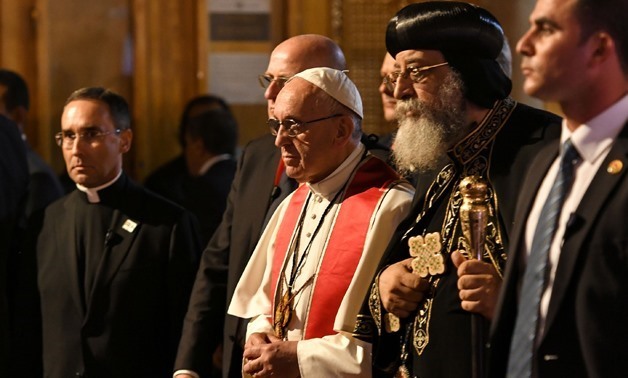
FILE- Pope Tawadros II and Pope Francis during his visit to Cairo on May 10, 2018
CAIRO – 1 July 2018: Pope Tawadros II, the Pope of Alexandria and Patriarch of the See of St. Mark, will lead on Friday a Holy Mass at the church of Saint Paul Apostle in Rome, the second largest church in Rome, according to a press statement released by Bishop Theophilus, the Bishop of Turenyo.
Pope Tawadros’ visit to Rome is the second of its kind. Pope Tawadros first visited Rome to congratulate Pope Francis for being the sovereign of the Vatican City State.
“Pope Tawadros will lead the mass at the church of Saint Paul Apostle in Rome,” Bishop Theophilus underscored.
He added that Pope Tawadros and his accompanying delegation would attend a meeting with the head of churches and patriarchs in Bari, Italy. Also, Pope Tawadros would visit San Paolo church, on the occasion of the feast of Saint Peter and Paul, where the prayer will take place on July 8.
To promote Christian Pilgrimage to Egypt, an exhibition of Egyptian Antiquities and Coptic icons has kicked off in May and will last until September 2018 in Viterbo, Italy.
The number of Orthodox Copts in Italy has reached 800,000 Christians, Bishop Theophilus said. He also confirmed that Coptic and Pharaonic exhibitions play an important role in enhancing relationships between the two countries.
On June 17, Egypt received the first group of pilgrims from Italy accompanied by Monsignor Fumagalli, the Roman Catholic diocese of Viterbo and Anba Barnaba, the bishop of Torino and Rome, to tour the path of the Holy Family's journey in Egypt.
History of The church of Saint Paul Apostle:
The church of Saint Paul Apostle was erected during the fourth century AD; it also is one of the four major churches in Rome.
When Paul the Apostle was executed in the first century AD in Rome, his followers built a shrine over his grave. In 324, they also consecrated a small church on the same grounds, but later in 395, this small church was demolished so as to construct a larger and more beautiful basilica.

St_pauls_outside_the_walls- CC via Wikimedia
The monastery’s striking cloister was built between 1220 and 1241. The cloister is one of the few parts of the Basilica which survived in the fire of 1823.

Rome, Saint Paul Outside the Walls, cloister- CC via Wikimedia
After the fire, many countries donated for the restoration of the church, which was reopened in 1840.
The interior of the Basilica of St Paul is magnificent, with enormous marble columns and beautiful gold mosaics. Despite the 1823 fire, few parts of the Medieval basilica remained intact.

Front of the Basilica of Saint Paul Outside the Walls - Roma - Italy- CC via Wikimedia
On the basilica’s walls, visitors will be able to observe the portraits of the popes, while a ray of sunlight lights up the portrait of Pope Francis.
---Roma---Italy--CC-via-Wikimedia.jpg)
Apse mosaic of the Basilica of Saint Paul Outside the Walls (1220) - Roma - Italy- CC via Wikimedia
The church of Saint Paul Apostle still contains the chains that were used to bind Saint Paul as a prisoner in Rome From 61-63 AD. These chains were displayed in a gold reliquary near the Apostle’s tomb and they became available for public veneration. On the feast day of Saint Paul each year, the chains are taken in procession around the Basilica.



---Roma---Italy--CC-via-Wikimedia.jpg)
Comments
Leave a Comment